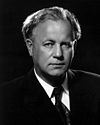President of Iceland
| President of Iceland | |

|
|
| President's coat of arms | |

|
|
| Flag of the president | |
|
Acting President Guðni Th. Jóhannesson since August 1, 2016 |
|
| Official seat | Bessastaðir in Garðabær |
| Term of office | 4 years (unlimited re-election possible) |
| Creation of office | June 17, 1944 |
| Last choice | June 25, 2016 |
| website | www.forseti.is |
The President of Iceland ( Icelandic forseti Íslands ) is the elected head of state of Iceland .
There have been six presidents since Denmark gained independence in 1944. The first president was Sveinn Björnsson . The current mandate holder has been Guðni Th. Jóhannesson since 2016 .
Until 1973, the seat of the President was the Alþingishúsið Parliament House . Since then he has been at the Bessastaðir manor in Garðabær municipality ( Álftanes until 2012 ).
Requirements for an election
Each candidate must have between 1,500 and 3,000 eligible voters and must be generally eligible to vote and be at least 35 years old.
choice
The president is elected by general, direct and secret ballot with a simple majority for a term of four years. If there is only one candidate, a silent election takes place, i.e. there is no voting, and the candidate only has to officially declare acceptance. The constitution does not limit the number of terms of office of a president.
Powers
According to the constitution, the state president has extensive powers: he appoints and dismisses members of the government without a parliamentary vote, represents Iceland under international law and exercises legislation together with the Althing parliament . The latter point manifests itself in a limited right of veto . Laws can come into force without his consent, but then they must be subjected to a plebiscite immediately . This can only happen once per legislative period.
In fact, the president traditionally limits himself to representative tasks and appoints the prime minister who is nominated by a majority in parliament. When President Ólafur Ragnar Grímsson made use of his veto right for the first time in the history of Icelandic democracy in 2005 , this right was promptly denied him by respected constitutional lawyers, arguing, among other things, that the traditional political abstinence of public officials had established a constitutional reality, which precedes the letters of the constitution. The law was ultimately withdrawn and there was no vote.
The Icelandic Constitution stipulates that the powers of the President pass to the Prime Minister , the President of the Althings and the President of the Supreme Court if the President is unable to perform his duties locally, such as when traveling or having surgery under anesthesia .
Terms of office
All former Icelandic presidents have served multiple terms. Sveinn Björnsson, the first president, was first elected for one year and died during his second four-year term. The following Ásgeir Ásgeirsson officiated for sixteen, Kristján Eldjárn twelve years. Vigdís Finnbogadóttir , the first woman in the world democratically elected to the office of president, did not run after four terms. Ólafur Ragnar Grímsson was incumbent for five terms from 1996 to 2016.
Official
| # | image | Surname | Term of office | comment |
|---|---|---|---|---|
| 1. |

|
Sveinn Björnsson (1881–1952) |
June 15, 1944-25. January 1952 | Sveinn was the first President of Iceland and previously the Regent of Iceland. In 1944 he was directly elected for one year by the Althing . His term of office was extended in 1945 and 1949 as there were no opposing candidates. So far, Sveinn was the only president to die during his tenure. |
| 2. |

|
Ásgeir Ásgeirsson (1894–1972) |
August 1, 1952-31. July 1968 | Ásgeir was the first popularly elected president. After his election in 1952 , his term of office was extended in 1956, 1960 and 1964 as there were no opposing candidates. |
| 3. |

|
Kristján Eldjárn (1916–1982) |
August 1, 1968–31. July 1980 | Kristján won the 1968 election and had no opposing candidates in 1972 and 1976. |
| 4th |

|
Vigdís Finnbogadóttir (* 1930) |
August 1, 1980-31. July 1996 | Vigdís was the world's first elected female head of state. She won the 1980 election . In 1984 and 1992 she had no opposing candidates. In the 1988 election she prevailed against Sigrún Þorsteinsdóttir. It was the first time in Icelandic history that an incumbent president was challenged by an opposing candidate. |
| 5. |

|
Ólafur Ragnar Grímsson (* 1943) |
August 1, 1996-31. July 2016 | Ólafur won the 1996 election with 41 percent of the vote. In 2000 he had no opponents, in 2004 he won the election. In 2008 he again had no opponent, in 2012 he was re-elected with 52 percent of the vote. Ólafur is the first Icelandic president to exercise his right of veto and the first to have five terms. |
| 6th |

|
Guðni Th. Jóhannesson (* 1968) |
August 1, 2016 - officiating | Guðni won the 2016 election with 39 percent of the vote, ahead of the entrepreneur Halla Tómasdóttir with 28 percent and seven other candidates. In the 2020 election he was re-elected with 92.2 percent of the vote; the only opposing candidate was Guðmundur Franklín Jónsson . |
See also
Individual evidence
- ↑ Forsetakjör 1996 - Hagstofa Íslands (English)
- ↑ Archived copy ( Memento of September 3, 2007 in the Internet Archive )

